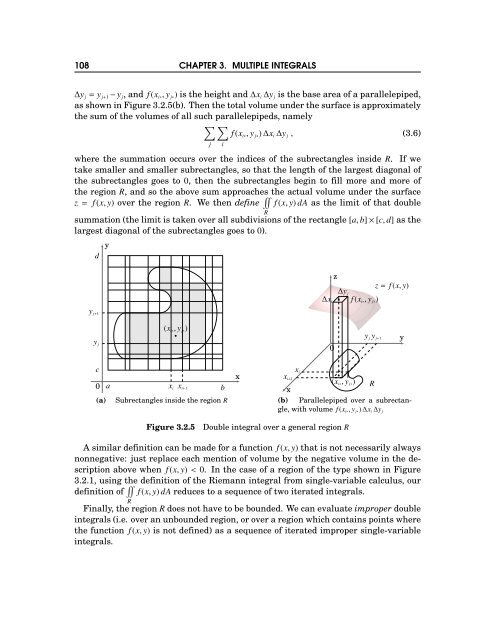Michael Corral: Vector Calculus
Michael Corral: Vector Calculus
Michael Corral: Vector Calculus
You also want an ePaper? Increase the reach of your titles
YUMPU automatically turns print PDFs into web optimized ePapers that Google loves.
108 CHAPTER 3. MULTIPLE INTEGRALS<br />
∆y j = y j+1 −y j , and f(x i∗ ,y j∗ ) is the height and∆x i ∆y j is the base area of a parallelepiped,<br />
asshowninFigure3.2.5(b). Thenthetotalvolumeunderthesurfaceisapproximately<br />
the sum of the volumes of all such parallelepipeds, namely<br />
∑∑<br />
f(x i∗ ,y j∗ )∆x i ∆y j , (3.6)<br />
j<br />
i<br />
where the summation occurs over the indices of the subrectangles inside R. If we<br />
take smaller and smaller subrectangles, so that the length of the largest diagonal of<br />
the subrectangles goes to 0, then the subrectangles begin to fill more and more of<br />
the region R, and so the above sum approaches the actual volume under the surface<br />
z= f(x,y) over the region R. We then define f(x,y)dA as the limit of that double<br />
R<br />
summation (the limit is taken over all subdivisions of the rectangle [a,b]×[c,d] as the<br />
largest diagonal of the subrectangles goes to 0).<br />
d<br />
y<br />
z<br />
z= f(x,y)<br />
∆y j<br />
f(x i∗ ,y j∗ )<br />
∆x i<br />
(x i∗ ,y j∗ )<br />
y j+1<br />
(x i∗ ,y j∗ )<br />
y j<br />
c<br />
0 a x i x i+1 b<br />
(a) Subrectangles inside the region R<br />
x<br />
y j y j+1 y<br />
0<br />
x i<br />
x i+1<br />
R<br />
x<br />
(b) Parallelepiped over a subrectangle,<br />
with volume f(x i∗ ,y j∗ )∆x i ∆y j<br />
Figure 3.2.5 Double integral over a general region R<br />
A similar definition can be made for a function f(x,y) that is not necessarily always<br />
nonnegative: just replace each mention of volume by the negative volume in the description<br />
above when f(x,y)








